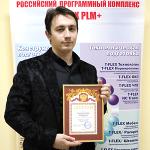At first I just liked playing chess, and then my coach appeared on Skype. In addition, every day I study for three hours myself and with a trainer in Voronezh, and my parents and I also teach YouTube blog. I have a store at home - I sell sweets there, and a hairdresser where I do my mother’s hair.
I've been going to competitions for a long time, and I like everything there. Especially to win! When I win a tournament, they give me a cup. And mom and dad buy a large chess piece. When I win many, many times, I will collect a complete set! We will make a chess floor in the room and put all the pieces there.
I go to school, I'm in first grade. What I like most is mathematics and drawing. More reading: My favorite book is The Wizard of Oz. In the future I want to be a teacher, a candy seller or a hairdresser. I don't want to teach chess. If I become a coach, then it will be difficult for me to move forward, but I want to become a world champion.
On the eve of the New Year, a “Young Leader” was elected in Lipetsk. The fight for this title was serious. Let us remind you that ten Lipetsk residents “fought” for victory in the competition. According to the sum of points, the victory went to Alexey Kuzmin. The young man received a diploma, a cup and 30 thousand rubles. Second place went to choreographer Victoria Borisenko, third place was shared by Kirill Yakimovich and Dmitry Ivanov. They received 20 and 10 thousand rubles. But the winner of the online voting was Alina Lazurenko, a laboratory assistant at school No. 61.
the site met with leader Alexey Kuzmin and found out what victory tastes like, and also found out plans for the future.
- What does winning the “Young Leader” competition mean to you?
For me, winning the competition is a new impetus for personal development. Such events give a lot of strength and self-confidence. This victory also showed how much my family and friends believe in me. They supported me throughout all stages.
- What were your emotions when you found out that you were the winner?
I was very surprised because I didn’t think about the result when I was preparing for the final. But I was pleasantly surprised, because victory is victory!
- What changed in your life after participating in the competition?
It's hard to say what has changed in life. Immediately after the finals, I plunged into the session, the competition, and no one canceled my studies. The organizers promised that next year I would also take part in the competition.
- The further fate of the project, will it be continued?
The project will definitely take place again, but its format will undergo significant changes. It was implemented for the first time and this immediately showed its weaknesses. We will work on them. And in April we plan to launch it for the second time.
- How did the project influence you, what did it give you personally?
The idea of the project itself was born from my personal need for information and skills that project participants receive. I myself am a graduate student, and the issue of employment is important both for me and for my fellow students. Therefore, when we were preparing for the stages of the project, developing materials with a real HR manager, I acquired a lot of knowledge for myself personally.
- What is your attitude towards such competitions, how much do young people need them, what does participation in them give?
Of course, such competitions are necessary for young people. And it’s great that they are held in our city. They allow young, talented, active children to express themselves and their activities. I know for sure that most of the participants in this competition are engaged in socially significant projects outside of it. But few people know about this. So the competition allows us to tell and show that useful and interesting work is being done around us. Well, the competition itself gives an incentive to work further and confidence that the direction of this work is correct. That's what happened to me.
- In 10 years, describe yourself.
Family, work, which does not oblige me to stay in one place, but allows me to move around the world the way I want.
Let us remind you that Alexey implemented the “Start-up of your career” project.
|
Natalia Serafimovna, please tell us about your participation in our competition: how was the decision made, what were the problems when working on the project, what helped you win, what did this victory mean to you? It wasn't without difficulties. The most difficult thing in mastering the program was remembering the outline I didn’t like as a student. But here it has come to life and is helping to fulfill wonderful design ideas. Although sometimes imagination and flight of thoughts led to a dead end when designing. In such cases, and in any case, even small ones, the developers, in particular Andrey Nikolaevich Efremov, do not leave without consultation. And in difficult situations, business trips can save you. For the competition, I chose simple devices for chemically cleaning prisms of various configurations. I wanted to demonstrate the parameterization of the program, which gives a high level of productivity in design work. The work, which I did slowly, took me approximately 2 weeks, with most of the time spent creating one parametric model of the fixture. |
The reaction of my work colleagues was not joyful, but rather surprised. The achievements of programmers (and we, users of the T-FLEX CAD parametric program, are partly programmers too), unfortunately, are not clear to the surrounding non-specialists. But the rating in the team has definitely increased. Both in 2010 and 2012 my followers took part in the competition. Both took first place.
- What advantages of working with T-FLEX can you note?
Firstly, I prefer domestic manufacturers in everything. In general, we Russians need to help each other, thereby saving our economy. And then the fact that the developers are Russian is so convenient: any wishes and whims regarding functionality are welcome, seminars, the opportunity to communicate with like-minded people. And everything is fine with work.
- Which project of other competition participants did you like?
It seemed to me then that my project was simple, probably because it was clear to me, but others… Everyone was strong and worthy! I also remember the winning project in the cool category “The most understandable project” - “Folding grill”. To tell you a secret, I asked myself to download it. Now I have a “Folding Brazier”. Only I didn’t use it. As it turns out, it’s cheaper to buy today...
I definitely want everyone to participate! After all, creating a project is our professional design work. You just need to take the time to prepare everything and send it.
- What are you working on now, are you going to send your work to the competition again?
I don’t know yet whether I will participate in the competition again. I am more interested in working together with CAD developers under the title “Creating a Project”, so that in the project you can assign and easily edit its code, positions, names of unloaded parts, etc.
Winner of the 2012 “Expert” competition, Svetlana Nikolaevna Efimova,
JSC "Eletsgidroagregat"
Why did you decide to participate in our project competition, what prompted you?
It's interesting to try your hand and compare your capabilities with other users.
How long have you been working with T-FLEX? Where did you start?
I got acquainted with T-FLEX back in 2000. I started by developing parameterized models of the most popular machine tool parts to make my work easier.
What was the most difficult part of designing a product in T-FLEX?
The most difficult thing when designing a product is to establish the so-called rules of the game. That is, the principle of constructing each model so that it is possible to easily edit variables. The comment must be necessary and sufficient.
What helped you in your work?
Constant contact with the program developers helped. As well as information about the program.
What attracts you most about T-FLEX CAD?
Unlimited parameterization possibilities.
At that time, parameterization of the design of hydraulic cylinders was a priority task for our company.
About 3 months
The downhole flaw detector is a very interesting model.
I don’t remember, I’ve changed my computer since then.
Are you going to participate in the next competitions?
It would be very interesting.
Colleagues were proud that a representative of our plant won. This was just as significant for the company; in addition, for this development I was awarded the title “Engineer of the Year.”
What would you like to wish to future participants of the competition?
Get creative and good luck!
Winner of the 2012 “Expert” competition Eric Shakirov,
Gribanovsky Machine-Building Plant
|
|
- Why did you decide to participate in our project competition, what prompted you?
- What was the most difficult thing when designing a product in T-FLEX CAD?
|
- What helped you in your work?
The main assistance in the work is provided by the parameterization tools included in T-FLEX CAD.
Of course, the possibilities of parameterization.
Mini-CAD for automating the process of precise labor regulation
Enterprise: OJSC "Teplopribor", Ryazan
System for automated calculation of the cost of ordering the production of the “Piston” part
Enterprise: MSTU "MAMI", laboratory "Youth Design Bureau"
- Is winning the competition significant for your company?
The use of T-FLEX software products at our enterprise is explained by the fact that today the set of programs created by the Top Systems company has no alternative in terms of cost of ownership, coverage of tasks to be solved at the enterprise and the ability to exchange data with other design and accounting systems.
Recognition of our work “Air Cooling Apparatus” as the winner of the “Expert-2012-2” competition means that our enterprise has professionals who can solve the problems set by management, and there is potential for further improvement.
About the company:
Gribanovsky Machine-Building Plant (Borisoglebsk, Voronezh region) was founded more than 70 years ago. The plant produces air cooling units, heat exchange and capacitive equipment for oil and gas production, oil refining, chemical and metallurgical industries.
Perfilyev Pavel Valentinovich, multiple winner and prize-winner of the Expert competition
|
|
How did your participation in project competitions begin?
How long have you been using T-FLEX CAD?
|
How could you describe the pros and cons of working with T-FLEX CAD?
T-FLEX - The tool is good. There are no particular difficulties. Sometimes it’s annoying to have to take unnecessary steps when designing drawings - I would like something like design styles for dimensions, inscriptions, etc. The advantages are the flexibility of the system, the ability to adapt to different tasks, powerful parameterization, and I would especially like to note the planning mechanism - in our projects this approach does a lot to increase the productivity of the designer.
Why did you choose this particular model for the competition?
This model can fully demonstrate all the advantages of the program. Well, the model itself is quite complex and interesting to work with. While working on the model, I came up with new techniques for working with T-FLEX, which were later developed on other projects.
How long did it take to complete the project?
It’s difficult to estimate unambiguously, since you often have to work on parallel projects, but approximately 2 months.
What models of other competition participants did you find interesting?
Projects from OJSC Anzheromash.
What computer configuration was the model created on?
AMD Athlon 54x2 Dual Core Processor 4600+ 2.41 GHz, 3.50 GB RAM ATI Radeon HD 3600 Series.
Are you planning to participate in the next competitions?
Perhaps, given time. And if there is any original object in the works.
How did your colleagues react to your victory? Is your victory significant for the company?
Congratulations on your victory. We always include all diplomas for prizes in materials when participating in various competitions for design work. Sometimes this plays a certain role in the customer’s selection of performers.
What are your wishes for future participants of the competition?
Victory
Winner of the “Expert 2009” competition Sergey Vasilievich Maksimov,
OJSC "PO Sevmash", Severodvinsk
|
|
- What works have you submitted to Top Systems competitions?
Why did you decide to participate in our project competition and what motivated you? Why did you choose these particular models for the competition? |
- On what configuration of computer was the model created?
The “Distribution gearbox” project was completed at the end of 2002 in T-FLEX CAD version 7.2 on a computer with an AMD Duron processor with a clock frequency of 650 MHz and 192 MB of RAM (two sticks of 128 and 64 MB) and a 1 MB video card. The project "TPO Ship v2.0" was completed at the end of 2008 on a computer with a Pentium 4 processor with a clock frequency of 3.2 GHz and 1 GB of RAM.
It took about two months to write the thesis (12 hours a day), along with calculations in an explanatory note for 110 sheets and 12 sheets of A1 drawings.
- What was the most difficult thing when designing a product in T-FLEX?
The main difficulties in developing the transfer gearbox were related to the low performance of the computer. Still, the gearbox is quite large (620 parts) for such a weak machine. And when implementing the project "TPO Ship v2.0" - creating a model of a warship with complex hull contours in a mechanical engineering system, and mastering programming in C# from scratch.
- What attracts you most about T-FLEX CAD?
Freedom of action. If other CAD systems are built on the principle of a corridor - “follow the algorithm and build a model”, make changes also according to a predefined algorithm, then T-Flex CAD is more of a field, and everyone tramples the paths in this field for themselves, developing their own design methodologies in the system .
- How long have you been working with T-FLEX? Where did you start?
I started studying T-Flex CAD in my second year in March 1999 with version 5.3. The system was taught to us by Pavel Valentinovich Perfilyev, who at that time worked at our university as the head of the department of “Design of handling, transport and technological equipment” and taught us the course “Machine Parts”.
-Are you going to participate in the next competitions?
Maybe yes.
- What would you like to wish to future participants of the competition?
Enter the competition only with an original idea or technology in order to show others new horizons in the use of T-Flex CAD. In my opinion, what is important is not the victory itself, but the opportunity to demonstrate something new and unusual to colleagues.
Nesterenko Yuriy Grigorievich, senior lecturer at the department of “Equipment Technologies for Mechanical Engineering Production” of Cherkassy State Technological University, whose students have repeatedly become winners of the “Test” competition
|
|
Yuri Grigorievich, as far as we know, when studying at your department, students very actively use various CAD systems and, in particular, T-FLEX CAD developed by Top Systems? |
The students you train often take part in the “Test” and “Expert” competitions, which are regularly held by the Top Systems company. What pushes them to do this?
Of course, we are always happy to take part in the “Expert” and “Test” competitions held by the Top Systems company. First of all, because participation in such competitions encourages our students to study the functionality of T-FLEX CAD more deeply. But, even more important, participation in the competition teaches the student to take initiative, set a task for himself and solve it, overcoming possible difficulties.
One of the latest works of your students, which deservedly received the main prize of the last “Test” competition, was a three-dimensional model of the Eiffel Tower. Why did you choose this particular model for the competition?
The fact is that after the release of T-FLEX CAD 12, the Top Systems company assured users that the increase in graphics rendering speed could be up to 10 times or more compared to the previous version of the system. So we decided to practically test this statement by creating a truly complex three-dimensional model. And we chose the Eiffel Tower because it is known throughout the world and consists of many structural elements: decorative grilles, elevators, arches, which can be examined in detail.
You can't argue with that. According to our calculations, the 3D model of the tower contained more than one and a half billion polygons. Even we, the T-FLEX CAD developers, were surprised by the complexity of the model and the detail of all structural elements! How long did it take to complete the project?
Systematic work on the tower took about 7 months.
- How did you and your students manage to recreate the original so accurately?
When designing a three-dimensional model of the Eiffel Tower, we were guided by the first working drawings designed by French engineers at the end of the 19th century, as well as photographs, documentary chronicles on YouTube, panoramic views of web cameras transmitting images of the tower in real time via the Internet.
What difficulties arose in the process of creating the tower?
The first working drawings of the tower were made in French, and we had to translate them.
In addition, a particular difficulty in creating the tower model was determining, with an accuracy of up to a second, the inclination angles of the tower supports in two planes, but thanks to the parametric capabilities of the T-FLEX CAD system and its variable editor, this problem was successfully solved.
We, the developers of T-FLEX CAD, would like to know how our system performed when working with such a complex 3D model?
As I already said, the project began as a study of the capabilities of T-FLEX CAD when working with “heavy” models. And in this regard, the T-FLEX CAD 12 version has really moved far ahead compared to the previous one. By the way, it was when working with the Eiffel Tower that we first used the mode of working with large assemblies in T-FLEX CAD - and we were quite pleased with the speed, despite the rather modest computer by today's standards.
- As a result, on what computer configuration was the final assembly obtained?
The creation of the model and subsequent video presentation was carried out on a computer with an AMD Phenom II X4 955/ 3.2 GHz processor, 4 GB of RAM, and a GeForce GTS 450 video adapter with 1 GB of video memory.
- What projects of other competition participants seemed interesting to you?
“The Plow” by Eric Aidarovich Shakirov is worthy of taking his hat off. In addition, I had great respect for the project of the Crawler Tractor, V.I. Voronkov.
- Do you already know which model you will submit for the next “Test” competition?
Perhaps yes. But I’d better not talk about it for now. Let it be a surprise.
- We look forward to new projects of your students. Thanks for the interesting conversation.
Sergey Viktorovich Skolzkov, winner of the “Test-2010” competition
|
|
- Why did you decide to participate in the “Test” competition, what prompted you?
- How did you start learning T-FLEX CAD?
- Why did you choose this particular model for the competition?
- How long did it take to work on the project?
|
- What was the most difficult thing when implementing the project in T-FLEX CAD?
In this type of project, the most difficult thing is always achieving maximum photorealism. There are quite a lot of settings for materials and lighting in POV-Ray, its own syntax is used, the situation is aggravated by the almost complete absence of any documentation in Russian, good examples and like-minded people with whom one could communicate.
- What helped you in your work?
The belief that the project would be interesting and appreciated by the jury and other participants helped. We also hope that other users will become interested in photorealism through T-FLEX CAD.
- What attracts you most about T-FLEX CAD?
The “flexibility” of the system is very important to me – the ability to implement various tasks using it. Parametric, so to speak, programmable fragments allow you to quickly and efficiently create drawings or 3D models.
- Which models of other competition participants did you find interesting?
Among the “Expert” competitions, I was most impressed by the “Ship TPO” project. Among the “Test” competitions, I will select projects not according to the criterion of “complexity”, but according to the criteria of “originality” and “I just like it.” These are works such as: “Eiffel Tower”, “Design of 3D models of forged products”, “Turret lathe mod. 1341", "Bogdan bus", "UAZ car model".
Winning the competition means that my efforts were not in vain, and that’s nice. It’s also nice to hold the prize you receive in your hands.
- What would you like to wish to future participants of the competition?
I would like to wish you not to be afraid to set yourself non-standard tasks and find the strength to solve them. After all, when participating in a competition, everyone would like to win - that’s what it’s a competition for. And showing something unusual and interesting is a very big chance of success.
Winner of the “Expert” competition and the “Test” competition, Sergey Ivanovich Chinbay,
JSC "Cherkasy Bus"
|
|
- Why did you decide to participate in the “Test” competition, and then in the “Expert” competition? What prompted you?
- Where did your development begin?
T-
FLEX CAD?
|
- Why did you choose these particular models for the competition?
The 1341 turret lathe is interesting in that it can be attributed to the transitional stage of machine tools from manual control directly by the operator to CNC machines.
Any internal combustion engine in itself is interesting due to its design, and the presence of the Moskvich-412 determined my choice of this particular model.
- How long did it take to work on the projects?
It took two months to create the machine project, without taking into account the collection of the necessary information.
The internal combustion engine was modeled over a period of 6 months, taking into account the complexity of the design and the creation of the necessary base of fasteners specifically for the project.
- What was the most difficult thing when implementing projects in
T-
FLEX
CAD?
When creating components, special attention was paid to cast body parts. The complexity of the geometry due to the design required close attention and study of theoretical material.
- What helped you in your work?
The intuitive and convenient menu greatly simplified solving problems. Also, the wide possibilities for creating various curves and planes reduced the required time for modeling.
Linking drawings to 3D models made it easy to edit the dimensions of parts and assemblies.
- What attracts you most?
T-FLEX
CAD?
First of all, I would like to note the possibility of quickly modeling complex objects. There are also tools that allow you to animate processes occurring in mechanisms.
Secondly, highlight the parameterization of both individual parts and assemblies.
Thirdly, the compatibility of T-FLEX CAD file formats with programs such as Maya, 3Dmax, etc.
- Which models of other participants did you find interesting?
Interesting projects: Front axle of a car with a disc brake mechanism. OJSC "Ryazan Automobile Units Plant", Ryazan; Crawler tractor, Youth Design Bureau of MSTU "MAMI", Moscow
- What does winning the competition mean to you?
This is the beginning of the path to new achievements. After all, a completed project provides an additional incentive to develop and implement new ideas.
- What would you like to wish to future participants of the competition?
I would like to wish everyone great faith in themselves, as well as in the interesting ideas that surround us. Well, let everyone decide for themselves how to bring them to life.
Bookstore shelves are replete with all sorts of manuals with colorful titles “How to Succeed,” and all of them, of course, contain rational grain, but they do not provide ready-made recipes. Each person must define for himself what success is and achieve his own success. You don’t have to wait for a special reason to be happy; you need to program in yourself a willingness to enjoy life in all its manifestations. And when troubles come, remember the phrase of the great Solomon: “This too shall pass.”
Success, luck. Actually, what is it?
I think luck is something that suddenly falls on your head out of the blue, and the next day there is something so good. Unusual. And for free!
Luck leads to degradation of a person, while well-deserved success ennobles him! After all, in order to be successful, you don’t need to do anything, and, therefore, you don’t need to improve yourself. That is, dreaming about luck and relying only on it, your personality simply turns into a sick dystrophic person incapable of functioning!
Another disadvantage of luck is that it divides! If you want to achieve fame or etc., then you don’t need anyone, otherwise, God forbid, he will get more! This means that a person turns into a lone player. And the game itself becomes the goal of his life, which, in my opinion, is also wrong!
But success is completely different; it will be more difficult! For a business to be successful, you need to work hard! It is important to know that success is not a destination, but a lifestyle. You need to create in your mind a certain image of success that will be with you forever in the future. Thoughts are material and corresponding life situations will be attracted to you.
 I realized for myself that the main thing is To succeed, you need to participate in competitions.
I realized for myself that the main thing is To succeed, you need to participate in competitions.
There is no need to be afraid of being a loser, there is no need to be ashamed of defeat, it still leads to victory. My mother always told me from childhood: “Be sure to take part in competitions. If you don’t win, we won’t be surprised, but what if?!”
And this “suddenly” happened to me often:
I won for the first time at the age of 8, participating in a drawing competition on asphalt for Children's Day. Not because she drew well, but all the characters, from flowers to little men, smiled.
My New Year's Cinderella costume, made of gauze, was recognized as the best in the third grade, but I was embarrassed by the attention and ran away from the reward - orange slices and a doll.
I first learned about failure at the age of 10, when I took part in a sports race and came last, my sneakers came untied and the boys pushed me off the treadmill. I remember our class started yelling at me, which I destroyed out of hope.
But a year of training and jogging around the house and I became a runner not only in class, but also in school for three years. Self-discipline became second nature to me.
Then there was a victory at the age of 12 in the school theater, when I, wearing galoshes and my grandmother’s scarf, portrayed Baba Yaga. And before that there were tears that they wouldn’t take me for the role of Alyonushka’s sister. Gift - a book about cutting and sewing.
And there was a defeat in the chemical regional Olympiad. And classes with tutors during the holidays, reading, and then it helped in life.
I lost at chess, I didn’t pass the city poets’ competition, I didn’t get into teacher training school. How many tears and what disappointment in myself. But you need to try, look for yourself.
I learned to play the piano. I did not become a composer, but I play well and music comforts my heart.
I entered a technical university and graduated with honors. But it’s not just my success and effort - it’s the dedication of my mother, who taught me.
I won the competition for the vacant position and am very pleased with my job.
I took part in promotions and won an apron from Gallina Blanca cubes, a beer mug from Lviv Beer, and samples of shampoos while dancing on the beach of Yalta.
I realized that in order to overcome difficulties, you need to rejoice in the victories of other people, and admire that someone worked harder than me. You must not be afraid of being ridiculed. And laugh at failures. Here's the great rule for success: your life will only get better as you get better.
It’s better to do it and regret it than not to do it and regret it.
If I lose, then I don’t care how it looks from the outside.
Important for me:
1) make every effort, that is, do everything to win;
2) to gain positive experience, that is, I am not so proud as to say: “All or nothing,” I can also play a supporting role;
3) don’t blame anyone for your defeat (“Yes, they bought all the places”, “The judge condemned”, “They just gave them a hard time”, etc.).
 If you don't believe in yourself and your success, how are you going to achieve anything in your life? Many people believe that successful people are confident precisely because they have achieved success and can afford it. And few people realize that these people achieved success thanks to their confidence. That is, confidence appears first, and then success. And not the other way around. Success doesn't stick to losers. It is very difficult to be confident in yourself when life is not going well, the job is not the same, and the salary is not particularly encouraging. But this is precisely the strength of this test. Be confident and happy no matter what. And success and luck will not keep you waiting long.
If you don't believe in yourself and your success, how are you going to achieve anything in your life? Many people believe that successful people are confident precisely because they have achieved success and can afford it. And few people realize that these people achieved success thanks to their confidence. That is, confidence appears first, and then success. And not the other way around. Success doesn't stick to losers. It is very difficult to be confident in yourself when life is not going well, the job is not the same, and the salary is not particularly encouraging. But this is precisely the strength of this test. Be confident and happy no matter what. And success and luck will not keep you waiting long.
Therefore, I will tell you a secret that people stubbornly do not want to notice: “Simply reading books will never change your life.”
Your life will only change when you roll up your sleeves and take action.! From tomorrow, become fully responsible for everything that happens in your life. You need to read good books and be a kind and sympathetic person. Only then will your life begin to change.
You just have to remember one very important thing. No one is better than you, and no one is smarter than you. Let me repeat these words again.
I believe, that TO ACHIEVE SUCCESS YOU NEED:
1. Set yourself a goal.
2. Go and strive for this goal.
3. Perseverance and composure.
4. Do not retreat from the steps taken.
5. Persistence.
6. Zeal for victory.
7. The ability to prove yourself.
8. Communication skills.
9. Don't forget about your friends.
What's it worth remember when achieving success:
1. Don’t be too preoccupied and don’t turn up your nose.
2. Remember that you have friends.
3. Treat people the way they treat you and the way they deserve it.
"Won first place and a prize of 10 thousand rubles.
In Ksenia’s work, the style of Japanese manga is organically intertwined with Russian fairy tales and Slavic mythology. Here you have a learned cat, beautiful girls with eyes that fill half their faces, Ivanushka and Alyonushka, bishounens of Slavic appearance, Baba Yaga and other elements of Russian folklore. Ksenia’s experiment once again proves that the stylistic hybridization of manga is in full swing and has no intention of stopping.
What does winning the competition mean to you?
Winning or taking some prizes is certainly a pleasure. But what makes me most happy is that people liked the trial work on the theme of Rus' :)
Have you participated in similar competitions before?
No, this is my first time participating in a competition dedicated specifically to manga/comics.
How do you feel about the appearance of the competition? TIMcontest?
I think it’s just a great idea to hold such Internet competitions in Russia. More artists will be able to express themselves, show their work, and listen to the opinions of readers. When participating in similar competitions in other countries, most often you only find out whether you won or not.
Are you satisfied with the terms and requirements of the competition?
On the one hand, I was pleased with the fact that the competition went quickly, and I didn’t have to wait six months for everyone to send in their work, and another six months for the results to be announced. On the other hand, not everyone can create a comic or manga so quickly. Perhaps the timing should have been a little longer. Which, by the way, they have already done X)))
“Kudo” is your real name or a pseudonym?
Nickname:) This refers to Japanese freestyle wrestling.In kudo, all techniques are allowed, except for strikes to certain parts of the body. That is, hit wherever you want, but don’t forget about humanity. So I do everything to achieve the goal, but I take care of myself so as not to stoop to the level of those who “go over their heads”, no matter what.According to Wikipedia:
“The founder of the style, Japanese Azuma Takashi, is a philosopher by training, and the name carries another meaning, consonant with ancient Chinese wisdom: “There is no gate leading to the Great Path. Everyone must build them in their hearts and go towards perfection on their own path."
This statement fits my worldview very well.
Tell us a little about yourself. In what year and how did you start getting acquainted with manga and comics?
I am 26 years old. I don’t remember the year, but I learned about anime in 8th grade. A friend told me about him. Like many, it was Sailor Moon))) At first I simply copied the characters from there, then I began to invent my own. Actually, I started drawing in 4th grade. And I became interested in comics at the same time. I used up a bunch of notebooks on them. I learned about manga later, when I graduated from high school and entered college to specialize in wood painting. Many manga artists like it. Especially Arina Tanemura and team "Clamp". It’s true that I’ve been trying not to look at Tanemura’s work lately, because they influenced me greatly))))
How long did it take you overall to create the Medallion manga and how many days did it take to draw one page? Did anyone help you?
No, I don't have any assistants. I love drawing everything myself too much)It took about a month to create the work. I can’t say anything about the page, because... I don’t pay attention to it during the process. Yes, and it turns out differently. Today I have 1-2 pages, and tomorrow I can draw 6-8.




Describe the stages of working on a manga? What graphic editors and tools do you use?
First I draw everything in pencil, then I outline it with ink using an isograph. Rotring brands , I erase the pencil (sometimes I draw screentones) and scan. The only editors are Photoshop and Manga Studio. I clean it up in Photoshop and add it in Manga Studio screentones.
Tell us about your other works and plans for the future?

Perhaps the most The manga “Tailed Miracle” from the publishing house “Factory of Comics” is more well known :) The story in two chapters “Gin as a Gift” should be published in one of the issues of the collection “MNG. Almanac of Russian manga" Another one-volume “Time Machine”, but the drawing there is old and with a lot of errors)) Perhaps I will redraw it :) The first volume of the manga “The Unforgotten God”. There are a couple of stories that have been started, with one to several chapters ready, the plots of which I plan to rewrite. Plus a few singles.





The competition accepted works on any topic. Do you think this makes the task more difficult for the artist or is it easier to work on a given topic?
Artists are all different. Personally, it’s difficult for me to draw on a given topic; I don’t like frames. On the other hand, a single topic in a sense balances the chances of the participants.
Why did you choose a theme with national flavor for the competition manga “Medallion”?
Initially, it was an idea about heroes saving a goddess from a villain. At that time, I had thoughts of coming up with a story in our folk style. Plus, I often thought that sometimes the traditions of many peoples are, to put it mildly, strange. Ours are no exception))) I remembered weddings with the kidnapping and ransom of the bride))) And the story somehow appeared by itself.




Artists have certain difficulties when conveying scenes with movement (action). This is also lacking in competition entries. Why do you think this happens? Do you personally find such scenes difficult?
Mmm, I don't even know. Maybe because we're just getting started. The more often people draw, the better it will turn out. I haven’t drawn any special fights yet, but I think I’ll have to work hard too)))
What do you think is needed for the development of manga in Russia and the emergence of new interesting artists?
Difficult question) Time and perseverance, probably. Perhaps deeper enlightenment of the people.
What do you mean by the concept of “Russian manga”?
Manga drawn by Russian artists X))) Just like Chinese, Korean or any other. It will still remain a manga that originated in Japan. To be honest, I never thought about what it is and what it should be) After all, no one divides books into Russian, American or any African. So here, manga or comics are simply a way that the author uses to tell readers a story. Why reinvent another wheel when you can already ride it)




Your parting words to those who will participate in the next comic and manga competitionTIMcontest?
Go for it! The more participants, the more interesting)))
























